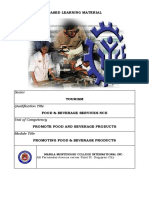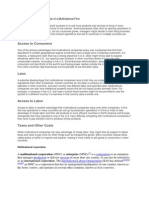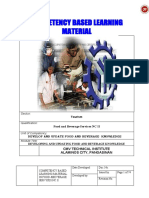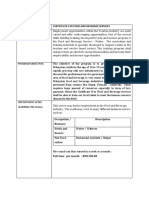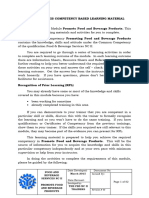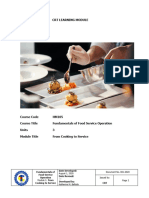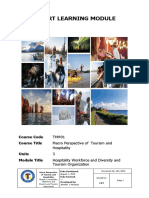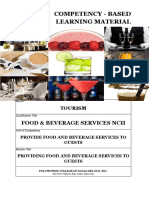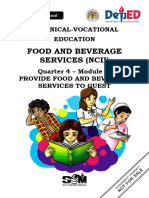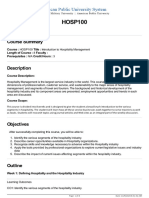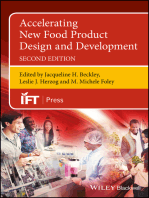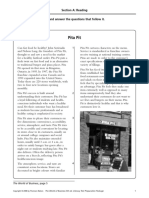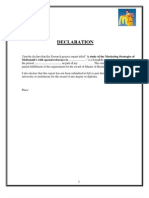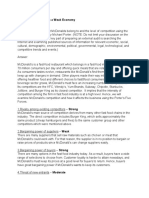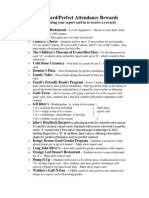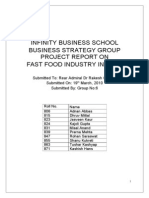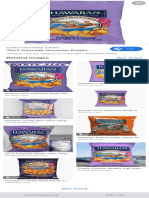THM03 MODULE 5 Food and Beverage Sector
THM03 MODULE 5 Food and Beverage Sector
Uploaded by
kathmb7380Copyright:
Available Formats
THM03 MODULE 5 Food and Beverage Sector
THM03 MODULE 5 Food and Beverage Sector
Uploaded by
kathmb7380Copyright
Available Formats
Share this document
Did you find this document useful?
Is this content inappropriate?
Copyright:
Available Formats
THM03 MODULE 5 Food and Beverage Sector
THM03 MODULE 5 Food and Beverage Sector
Uploaded by
kathmb7380Copyright:
Available Formats
CRT LEARNING MODULE
Course Code THM03
Course Title Micro Perspective of Tourism and
Hospitality
Units 3
Module Title Food and Beverage Sector
Document No. 001-2020
Micro Perspective of Date Developed:
Tourism and February 7, 2021
Hospitality Module 5: Date Revised: Issued by:
Food and Beverage Developed by: Page 1
Sector Jennifer J. Miranda CRT
College for Research & Technology of Cabanatuan
HOW TO USE THIS DIGITIZED LEARNING MODULE
Welcome to the module in Food and Beverage Sector. This module contains
training materials and activities for you to complete this module. This module also
covers the history of food and beverage service sector, the different types of
restaurants and their definition and example. This module will explain the advantage of
franchising in the restaurant industry and it will also describe the role of the menu in a
restaurants success.
You are required to go through a series of learning activities in order to
complete each learning outcome of the module. Each of the learning outcomes is
provided with Modules. Follow these activities on your own and answer the self-check
at the end of each learning outcome. You may remove a blank answer sheet at the end
of each module (or get the answer sheets from the online facilitator) to write the
answers for each self-check. If you have questions, don’t hesitate to ask your facilitator
for assistance.
This module was prepared to help you gain fundamentals and basic knowledge
about Tourism and Hospitality. This will be the source of Information for you to acquire
knowledge and skill in this particular trade independently and at your own pace, with
minimum supervision of help from your instructor.
Talk to your online facilitator and agree on how you will both organize the
Training of this unit. Read each through the module carefully. It is divided into
sections, which cover all the skills and knowledge you need to successfully
complete this module.
Work through all the information and complete the activities in each section.
Read Modules and complete self-check. Suggested references are included to
supplement the materials provided in this module.
Most probably your facilitator will be your supervisor or manager. Your online
facilitator will support and correct you.
Your online facilitator will tell you about the important things you need consider
when you are completing activities and it is important that you listen and take
notes.
You will be given plenty of opportunity to ask questions and practice on the job.
Make sure you practice new skills during regular work shifts. This way you will
improve both your speed and memory and also your confidence.
Talk to more experienced workmates and ask for their guidance.
Kindly the self-check questions at the LMS (EDMODO) to test your own progress.
When you are ready, ask your online facilitator to watch you online via Zoom or
Google Meet to perform the activities outlined in this module.
Document No. 001-2020
Micro Perspective of Date Developed:
Tourism and February 7, 2021
Hospitality Module 5: Date Revised: Issued by:
Food and Beverage Developed by: Page 2
Sector Jennifer J. Miranda CRT
Ask your online facilitator work through the activities: ask for written feedback
on your progress. Your online facilitator keeps feedback/pre-assessment reports
for this reason. When you have successfully completed each element, ask the
facilitator to mark on the reports that you are ready for assessment.
When you have completed this module, and feel confident that you have
sufficient practice, your online facilitator will arrange an appointment with
registered assessor’s to assess you. The results of your assessment will be
recorded in your competency Achievement Record.
Document No. 001-2020
Micro Perspective of Date Developed:
Tourism and February 7, 2021
Hospitality Module 5: Date Revised: Issued by:
Food and Beverage Developed by: Page 3
Sector Jennifer J. Miranda CRT
Micro Perspective of Tourism and Hospitality
Contents of this Learning Module
No. Module Topic Code
Title
•History of
the Food
and
Beverage
Service
5 Food and •Types of Module 5
Beverage Restaurants
Sector
•Franchisin
g
•Menus
Document No. 001-2020
Micro Perspective of Date Developed:
Tourism and February 7, 2021
Hospitality Module 5: Date Revised: Issued by:
Food and Beverage Developed by: Page 4
Sector Jennifer J. Miranda CRT
MODULE CONTENT
MODULE TITLE: Food and Beverage Sector
MODULE DESCRIPTOR:
Welcome to the module in Food and Beverage Sector. This module contains training
materials and activities for you to complete this module. This module also covers the
history of food and beverage service sector, the different types of restaurants and their
definition and example. This module will explain the advantage of franchising in the
restaurant industry and it will also describe the role of the menu in a restaurants
success.
NUMBER OF HOURS: 3 hours (1 week)
LEARNING OUTCOMES:
At the end of the module, you MUST be able to:
1. Describe the different types of restaurants.
2. Explain the importance of franchising to the restaurant.
3. Explain the role of the menu in a restaurants success.
4. Differentiate airline catering from restaurant catering.
5. Discuss restaurant promotion.
Contents:
1. History of the Food and Beverage Service
2. Types of Restaurants
3. Franchising
4. Menus
Conditions:
The students must be provided with the following:
1. Hard copy or soft copy of the course syllabus
2. MS Word
3. Pen
4. Paper
Assessment Method:
Document No. 001-2020
Micro Perspective of Date Developed:
Tourism and February 7, 2021
Hospitality Module 5: Date Revised: Issued by:
Food and Beverage Developed by: Page 5
Sector Jennifer J. Miranda CRT
1. Submission of Research paper.
2. Written examination.
3. Quizzes using Google forms.
MODULE 5
Food and Beverage Sector
Learning Objective: After reading this MODULE, you should be able to:
1. Describe the different types of restaurants.
2. Explain the importance of franchising to the restaurant.
3. Explain the role of the menu in a restaurants success.
4. Differentiate airline catering from restaurant catering.
5. Discuss restaurant promotion.
History of the Food and Beverage Service
In early history, there was much evidence that certain groups of people cooked
together in big groups and that the early Inns provided a crude menu. In the Roman
era, there were some establishments that offered sausage or roast meat, bread, and a
cup of wine. The forerunner of the modern restaurant that provides hot food and drink
developed in Rome. Many of the early restaurants were in the cities, near temples and
government buildings. After the fall of the Roman Empire, the manors and castles
provided food to large numbers of people. The early inns provided bread and wine to
travelers
In 1200, public cook shops were opened in London which offered precooked
takeout food. The royal families of Europe introduced cutlery, table linen, crystal
glasses, new foods such turkey and potato, and the roadside tavern sixteenth century,
British inns and taverns began to serve one meal a day at a fixed In the time and price
and at a common table. The meal was known as ordinary and the dining rooms were
called ordinaries. The most famous ordinary in London was the Castle and Lloyd's which
the meeting place was for merchants and ship owners. In the seventeenth century, the
ordinaries became fashionable clubs and gambling places as well as centers for political
activities. The word "restaurant” was used in the late eighteenth century for a Paris
dining room serving light dishes.
In the United States, taverns and inns were very similar to those in England. A
famous tavern in New York was Fraunces Tavern. In 1834, the famous Delmonico's
was opened in New York. In the early 1900s, several events that were significant to the
food industry occurred The hamburger was first served in 1904 at the St. Louis World's
Fair The first root beer stand was founded by Roy Allen and Frank Wright.
Document No. 001-2020
Micro Perspective of Date Developed:
Tourism and February 7, 2021
Hospitality Module 5: Date Revised: Issued by:
Food and Beverage Developed by: Page 6
Sector Jennifer J. Miranda CRT
The Second World War brought many changes to the American public People
became richer, the automobile made them more mobile, and they shifted to the
suburban areas of cities. In the 1960s, fast food establishments emerged.
Types of Restaurants
The following are the different types of restaurants:
1. Family or Commercial Restaurants
Family-style restaurants offer a wide menu of meat and potato selections with a
price range that appeal to an average family income. They serve beer and wine if they
have a liquor license. The decor is bright A combination of counters, tables, and booths
is common. Parking is necessary since customers usually arrive by car. Family
restaurants are normally located near a residential area and a highway
The operating hours are usually from early evening to midnight. The staffs are
friendly and efficient. The initial investment is medium to high.
2. Coffee Shops
Coffee shops are characterized by a fast-food service. The decor simple and
prices are relatively low. It is usually located in an office building or shopping mall. The
rent is high. The staffs are often minimally trained. The peak periods of a coffee shop
are lunch and coffee breaks, Operating hours are from early morning to early evening.
A takeout service may be offered.
3. Cafeterias
Cafeterias are usually located in shopping centers and office buildings Self
service is typical with limited menus of soups, entrees, desserts, and beverages.
Cafeterias often require a large preparation area. Their staff are minimally
trained. Beer and wine may be offered. Fast service is necessary to handle the traffic
volume. The operating hours will depend on the location as school, office building,
airport, or highway
4. Gourmet Restaurants
Gourmet restaurants generally require a higher initial investment than other
types of restaurants because they require an expensive ambience and decor. They cater
to those who want a higher standard and are willing to pay the price.
Cafeterias often require a large preparation area, their staff are minimally
trained. Beer and wine may be offered. Fast service is necessary to handle the traffic
Document No. 001-2020
Micro Perspective of Date Developed:
Tourism and February 7, 2021
Hospitality Module 5: Date Revised: Issued by:
Food and Beverage Developed by: Page 7
Sector Jennifer J. Miranda CRT
volume. The operating hours will depend on the location as school, office building,
airport, or highway.
The prices are higher at gourmet restaurants because of the high investment
required. The menu and wines are carefully planned and the staff is highly trained.
The evening period is the main emphasis. The location is important but may not
be critical since discriminating diners look for quality gourmet restaurants. Word-of-
mouth advertising and repeat businesses are keys to Success.
5. Ethnic Restaurants
Ethnic restaurants feature the food of a specific region or country. They can be
Chinese or classical French cuisine. The decor usually has an ethnic motif. In order to
be successful, ethnic restaurants must serve authentic cuisine of the region or country
they are featuring and those who prepare the food must be well-trained and
knowledgeable Prices range from budget to high. Beer, wine, and liquor may or may
not be served. The initial investment is high because of the decor and staff training The
location is variable. Operating hours are in the evening
6. Fast food Restaurants
Fast-food restaurants have increased in the past 20 years as people have
become more mobile. Franchising is common in this type of restaurant. The menu is
limited with low prices. Because of low prices, many customers patronize fast food
restaurants.
Fast-food restaurants operate for long hours and generally for seven days a
week Alcoholic beverages are not offered A well-trained staff is required for franchise
fast-food operation In which the franchisor sets standards of service and food quality
that must be maintained at all times.
Fast-food chains have been successful in the past two decades because they
have offered a limited menu. This has given them greater purchasing power, less
waste, and lower labor costs by using disposable paper, plastic, and Styrofoam
containers which save dishwashing costs. These restaurants are pioneers in establishing
more efficient food-operating systems.
7. Deli Shops
Deli shops provide delicatessen food service, combining traditional delicatessen
cold meats and cheese with takeout sandwiches, salads, and similar items. Some deli
shops have limited seating capacity. They are usually located in shopping areas or office
buildings and open from 9:00 AM to 5:00 PM or 900 PM. Capital investment is low. Deli
shops have low labor costs because only one or two owners and employees are
involved.
Document No. 001-2020
Micro Perspective of Date Developed:
Tourism and February 7, 2021
Hospitality Module 5: Date Revised: Issued by:
Food and Beverage Developed by: Page 8
Sector Jennifer J. Miranda CRT
8. Buffet Restaurants
Buffet restaurants are established on a completely self-serve basis. However, if
liquor, beer, and wine are offered, table and service for these beverages are provided.
The food buffet is usually an all can eat" hot and food for one price. Food
preparation and service staff are kept to a minimum. Buffet restaurants cater to the
family and therefore offer reasonable prices. They are open from 5.00 PM to 11:00 PM
9. Transportation Restaurants
There is a natural link between transportation and food services. Several
restaurants are generally found along auto and bus transportation routes They are also
found at bus, rail, and air transportation buildings, as well as on transportation vehicles
as trains and ships. Some transportation restaurants cater to tour groups, particularly
bus tour groups. These restaurants can be quite profitable if the market can be
maintained. They require special cafeteria or buffet-type facilities so that arriving
groups can be served quickly and continue on their journey.
Franchising
Franchised restaurants are a major component of the food service industry,
particularly in the fast-food sector. The reasons for the popularity of franchising in the
restaurant industry are very similar to those in the hotel industry. Franchises are
beneficial to the franchisees because they provide operational, training, layout and
design assistance, location assistance, managerial expertise, group purchasing power,
and most importantly, the identification of a well-known brand supported by regional,
national, and international advertising and promotion Franchised restaurants can easily
get financing from lending institutions than independents.
In the early days of franchising, the common practice was to sell individual
franchise rights for a single restaurant. At present, a regional franchise has become
popular with franchisees and franchisors A regional franchise allows a franchisee to
develop multiple outlets within a specific geographical area. The area could be a city, a
state, a province, a major part of the country, or the whole country For example,
Wendy's in the United States gave private Canadian Country the territorial rights to all
of Canada for Wendy's restaurant operations
Franchised restaurants include fast-food chains such as McDonald's, Kentucky
Fried Chicken, Pizza Hut, A&W Root Beer, and Burger King. They also include dine-in
types of restaurants such as Wendy's and Pizza Inn and carry-out establishments like
Orange Julius. The fast-food franchise is the most common Table-service restaurants
such as Denny's Steak and Ale and Victoria Station, and buffet-style restaurants such as
Document No. 001-2020
Micro Perspective of Date Developed:
Tourism and February 7, 2021
Hospitality Module 5: Date Revised: Issued by:
Food and Beverage Developed by: Page 9
Sector Jennifer J. Miranda CRT
Bonanza are also franchised. These table-service and fast-food restaurants have spread
from the United States to other countries throughout the world
Menus
The menu is the basic planning document for a successful restaurant. Several
aspects of the restaurant's operation depend on the menu. The menu contains what the
restaurant offers, the range of offerings, as well as the selling prices. The menu must
portray the style and theme of the restaurant. Thus, the menu's design, printing size,
and colors are important
The menu also determines the equipment needed and the investment required.
In general, the more extensive the menu is, the more varied the needed equipment will
be. If a restaurant sells only hamburgers, hotdogs, fries, and soft drinks, its required
equipment will be less compared to those of a restaurant with 20 or 30 menu items
which require different cooking methods and more specialized equipment.
In addition, the menu identifies the labor costs of a restaurant. It can determine
the number of staff required and the cost of staff training for food preparation and
service. The more items are contained in the menu, the more complex the service will
be
Lastly, the menu estimates the cost for uniforms, purchases, storage and space,
and actual food costs. The menu also helps emphasize, by means of bolder prints,
which menu items the restaurant would prefer customers to order.
Airline Catering
Airline companies spend billions of dollars every year for food purchases. The
average cost per airline passenger is between $1 and $7 depending on the length of
the journey. The amount is less for shorter trips, since passengers may be offered only
a non-alcoholic beverage and a light snack. For longer trips in which two or three meals
may be offered including free alcoholic beverages, the amount is higher. Around 3 to
4% of an airline's total costs is spent on food.
Food Quality
The main problem of airline companies is to cook the meal on the ground and
serve it several hours later in an extraordinary dry cabin atmosphere, seven miles high,
to different groups of people with their own food preferences, and whose main
motivation is to travel rather than to eat.
In 1992, airline passengers were served a sandwich and coffee from a vacuum
flask on a flight from London to Paris At present, particularly on long flights, passengers
expect hot meals
Document No. 001-2020
Micro Perspective of Date Developed:
Tourism and February 7, 2021
Hospitality Module 5: Date Revised: Issued by:
Food and Beverage Developed by: Page 10
Sector Jennifer J. Miranda CRT
Logistics
To produce hot meals, the airline companies have to prepare specifications for
recipes, ingredients, cooking methods and temperatures, and labor for each flight
These require a forecast using the actual passenger reservations for each flight
including an allowance for standbys and last-minute reservations in order to have the
correct raw materials, equipment, and food production staff for each shift. Preliminary
meal counts are usually prepared from 24 to 72 hours ahead: that food supplies can be
bought.
Menus must be carefully selected for each flight to avoid serving the same meal
to a passenger on two succeeding segments of a trip or on a round trip. In addition,
trays and serving utensils and supplies must be in the kitchen when the meal is
prepared.
Airplane Galleys
The first airplane galley was designed in 1936 by Douglas for its DC 3 Meals
prepared on the ground were kept hot or cold in insulated containers on the aircraft.
After World War II, the introduction of larger airplanes enabled them to have ovens and
refrigerators onboard in their galleys. The removable ovens are filled with hot food in
the ground flight kitchen, moved to the aircraft, and then plugged into electrical outlets.
Flight Kitchens
The first airline flight kitchen was opened in the late 1930s near Washington D.C.
Hoover Field airport by a gentleman named Marriott. He had a restaurant near the
airport. He noticed that passengers would go to his restaurant to eat before boarding
their flights because no meals were served in the airplane. He approached Eastern Air
Transport, now known as Eastern Airlines, and offered to prepare lunch boxes in his
restaurant for Eastern's passengers Eastern agreed, so the first flight kitchen was
established. At present, Marriott In-Flite Services has approximately 100 flight kitchens
around the world which cater to 150 different airlines and serve 100 million meals a
year.
There is an ongoing trend at present in which Flight Kitchen operators lease their
dining equipment from other firms.
Some airline companies have their own flight kitchens while others contract with
other airline companies that are equipped with their own kitchens. Most of the airline
companies turn over their catering services to outside caterers because airline kitchens
are not large and efficient.
Document No. 001-2020
Micro Perspective of Date Developed:
Tourism and February 7, 2021
Hospitality Module 5: Date Revised: Issued by:
Food and Beverage Developed by: Page 11
Sector Jennifer J. Miranda CRT
Difference Between Airline Catering and
Restaurant Catering
Airline catering is different from restaurant catering because in the latter, the
cooks can make last minute adjustments. For example, a steak might be prepared in
the flight kitchen to be accompanied by a sauce and vegetables to be served two hours
later. During this time, it must be kept hot. If there is fight delay of one hour, the steak
will be stringy, the sauce will be congealed, and the vegetables will be mushy. In an
ordinary restaurant, a meal this will not be served but on an airline, the serving crew
usually has no other choice but to serve it in airline catering the logistics are very
complex but airlines exert great efforts to serve good meals to the passengers. They
even respond to the needs of passengers on special diets if given enough notice
Restaurant Promotion
Many restaurants advertise their menu on newspapers. Local newspaper
advertisements are used by most restaurants as a major form of external promotion.
Several restaurants advertise in the yellow pages of the local telephone directory, some
use local radio or television stations. Most popular restaurants and national restaurant
chains advertise in airline in-flight magazines, consumer travel magazines, and travel
trade publications. Many restaurants try to foster good relations with nearby hotel
employees such as front office staff, bell desk personnel, and doormen because they
are often asked by hotel guests to recommend good nearby restaurants. Good public
relations and word-of-mouth advertising generate a lot of business.
Document No. 001-2020
Micro Perspective of Date Developed:
Tourism and February 7, 2021
Hospitality Module 5: Date Revised: Issued by:
Food and Beverage Developed by: Page 12
Sector Jennifer J. Miranda CRT
You might also like
- Specialized Food and Beverage Services - TMPE 121Document25 pagesSpecialized Food and Beverage Services - TMPE 121Anthony B. Anoche83% (6)
- Food and Beverage OperationsDocument350 pagesFood and Beverage OperationsMoses Mwah Muraya100% (12)
- JFC Process and Operation ManagementDocument13 pagesJFC Process and Operation Managementfriend friendNo ratings yet
- Digital Wealth A Guide To Making Money With Digital ProductsFrom EverandDigital Wealth A Guide To Making Money With Digital ProductsNo ratings yet
- CBLM Fbs NC II Lo# 3 Promoting Food and Beverage ProductsDocument104 pagesCBLM Fbs NC II Lo# 3 Promoting Food and Beverage ProductsJoshua Conde50% (10)
- THM07 Module 1 Tourism MarketingDocument14 pagesTHM07 Module 1 Tourism Marketingjennifer miranda100% (1)
- THM07 Module 2 The Tourist Market and SegmentationDocument14 pagesTHM07 Module 2 The Tourist Market and Segmentationjennifer mirandaNo ratings yet
- FOOD and BEVERAGE Services NC II Quarter 3 Module 3 Weeks 9 12 SDO Rizal IDEA Module SHS Template UpdatedDocument45 pagesFOOD and BEVERAGE Services NC II Quarter 3 Module 3 Weeks 9 12 SDO Rizal IDEA Module SHS Template UpdatedArvincent Geronimo Olatan100% (8)
- Dissertation Synopsis DominosDocument6 pagesDissertation Synopsis DominosMalatiDashNo ratings yet
- AdvantagesDocument15 pagesAdvantagesAkshay Anky100% (1)
- Drafting Outline of A Compare-Contrast EssayDocument4 pagesDrafting Outline of A Compare-Contrast EssayalexandraNo ratings yet
- THM03 MODULE 5 Food and Beverage SectorDocument12 pagesTHM03 MODULE 5 Food and Beverage SectorEdson de GuzmanNo ratings yet
- THM07 Module 5 The Tourism ProductDocument16 pagesTHM07 Module 5 The Tourism Productkathmb7380No ratings yet
- THM07 Module 3 Tourism and Consumer BehaviourDocument15 pagesTHM07 Module 3 Tourism and Consumer Behaviourjennifer mirandaNo ratings yet
- CBLM FBS 4 Develop and Update Food and Beverage KnowledgeDocument74 pagesCBLM FBS 4 Develop and Update Food and Beverage KnowledgeIrine IrineNo ratings yet
- THM03 MODULE 9 Tourism MarketingDocument17 pagesTHM03 MODULE 9 Tourism Marketingkathmb7380No ratings yet
- Learning Module 5Document17 pagesLearning Module 5kathmb7380No ratings yet
- THM03 MODULE 3 Tourism and CultureDocument11 pagesTHM03 MODULE 3 Tourism and Culturekathmb7380No ratings yet
- LM Week 1Document17 pagesLM Week 1judea dizonNo ratings yet
- THM07 Module 13 Tourism Marketing and Its FutureDocument10 pagesTHM07 Module 13 Tourism Marketing and Its Futurejennifer mirandaNo ratings yet
- Certificate II Food and Beverage ServiceDocument6 pagesCertificate II Food and Beverage ServiceMahendran SubramaniamNo ratings yet
- THM03 MODULE 10 Tourism PromotionDocument15 pagesTHM03 MODULE 10 Tourism Promotionkathmb7380No ratings yet
- Module On Banquet and CateringDocument169 pagesModule On Banquet and Cateringbarabas skyNo ratings yet
- Modulo III - Food and Beverage ManagementDocument10 pagesModulo III - Food and Beverage Managementkris kaye morenoNo ratings yet
- Competency Based Learning Materias: TourismDocument31 pagesCompetency Based Learning Materias: TourismJoshua Conde100% (1)
- Banquet and Catering Management - HRM 41.10: Contact Number: 09460926640 Email AddressDocument14 pagesBanquet and Catering Management - HRM 41.10: Contact Number: 09460926640 Email AddressAnthony B. AnocheNo ratings yet
- Core UC3 Promoting FB ProductsDocument82 pagesCore UC3 Promoting FB ProductsVanessa PondNo ratings yet
- Learning Module 1Document12 pagesLearning Module 1kathmb7380No ratings yet
- Mixing Drinks, Module 4 PDFDocument76 pagesMixing Drinks, Module 4 PDFJon GraniadaNo ratings yet
- Cblm Fbs NciiDocument116 pagesCblm Fbs Nciiysay torresNo ratings yet
- CBLM FBS 1 Provide Link Between Kitchen & Service Area ValidatedDocument105 pagesCBLM FBS 1 Provide Link Between Kitchen & Service Area ValidatedIrine IrineNo ratings yet
- OBTL Plan FSM 312:bartending and Bar Service ManagementDocument10 pagesOBTL Plan FSM 312:bartending and Bar Service ManagementJesseca CapiendoNo ratings yet
- THM 01 Module 7Document21 pagesTHM 01 Module 7Katherine BalbidoNo ratings yet
- FBSCORE6CBLM and Assessment ToolDocument52 pagesFBSCORE6CBLM and Assessment ToolJellane Seletaria100% (18)
- Study Guide Template EditedDocument4 pagesStudy Guide Template EditedFatima Nicole CoquillaNo ratings yet
- Cleaning Bar Area, Module 2Document45 pagesCleaning Bar Area, Module 2Annaliza AribanNo ratings yet
- Le Ngoc Quynh - Internship Report FinalDocument98 pagesLe Ngoc Quynh - Internship Report Finalthuhuong67ntNo ratings yet
- THM07 Module 8 Tourism Promotion IIDocument15 pagesTHM07 Module 8 Tourism Promotion IIjennifer mirandaNo ratings yet
- THM07 Module 7 Tourism Promotion IDocument18 pagesTHM07 Module 7 Tourism Promotion Ijennifer miranda100% (1)
- THM 01 Module 7 Hospitality Workforce and Diversity and Tourism OrganizationDocument21 pagesTHM 01 Module 7 Hospitality Workforce and Diversity and Tourism Organizationkathmb7380No ratings yet
- THM07 Module 4 Tourism Marketing and The Communication ProcessDocument13 pagesTHM07 Module 4 Tourism Marketing and The Communication Processjennifer miranda100% (1)
- Promote Food and Beverage ProductsDocument109 pagesPromote Food and Beverage ProductstampogmaryannNo ratings yet
- HPM 238 FOOD AND BEVERAGE PRODUCTION II - Teacher - Co - .KeDocument179 pagesHPM 238 FOOD AND BEVERAGE PRODUCTION II - Teacher - Co - .KeAloo Charles. OchukaNo ratings yet
- Ubd Template Marianne FrantzDocument23 pagesUbd Template Marianne Frantzapi-336516368No ratings yet
- Ubd Template Marianne FrantzDocument23 pagesUbd Template Marianne Frantzapi-336516368No ratings yet
- Ergo WordDocument54 pagesErgo WordJonnel GagalangNo ratings yet
- Report On Food OperationsDocument16 pagesReport On Food Operationsbright osakweNo ratings yet
- Provide Food and Beverage Services To GuestsDocument163 pagesProvide Food and Beverage Services To GuestsJemar DouglasNo ratings yet
- Quarter 4 Module 3 FBSDocument25 pagesQuarter 4 Module 3 FBSJovie ForsueloNo ratings yet
- HOSP100 SyllabusDocument8 pagesHOSP100 Syllabuscruces.bossNo ratings yet
- Preparing Dining Area For GuestDocument122 pagesPreparing Dining Area For GuestAel BaguisiNo ratings yet
- Assignment ModuleDocument9 pagesAssignment ModuleMasiur HossainNo ratings yet
- HCM 238Document175 pagesHCM 238ijeomaanokwuru52No ratings yet
- Course Guide Bar and BevDocument6 pagesCourse Guide Bar and BevRoy CabarlesNo ratings yet
- FBS 4Document9 pagesFBS 4mishiellsintos25No ratings yet
- Unit 28 World FoodDocument5 pagesUnit 28 World Foodchandni0810No ratings yet
- 2.0 - SITHKOP004 - Project - PART 1 - V92020Document31 pages2.0 - SITHKOP004 - Project - PART 1 - V92020taranjeet singhNo ratings yet
- THM07 Module 6 Pricing in TourismDocument14 pagesTHM07 Module 6 Pricing in Tourismkathmb7380No ratings yet
- FBS CBLMDocument330 pagesFBS CBLMRowena EspejonNo ratings yet
- Ubd Template Marianne FrantzDocument19 pagesUbd Template Marianne Frantzapi-336516368No ratings yet
- Economics for Investment Decision Makers: Micro, Macro, and International EconomicsFrom EverandEconomics for Investment Decision Makers: Micro, Macro, and International EconomicsNo ratings yet
- Competition Among Fast Food IndustriesDocument28 pagesCompetition Among Fast Food IndustriesSkyl3lueNo ratings yet
- Maharaja Group of Cloud KitchenDocument2 pagesMaharaja Group of Cloud KitchenKhushi RaiNo ratings yet
- How To Make BurgerDocument1 pageHow To Make BurgerMila MulianiNo ratings yet
- Franchise & License Expo Indonesia: Nama ProdukDocument2 pagesFranchise & License Expo Indonesia: Nama ProdukWidya AmandhaNo ratings yet
- Phan Tich 7p Cua Pizza 4psDocument89 pagesPhan Tich 7p Cua Pizza 4pshao.p.mNo ratings yet
- Cardiovascular Disease and Diet 1Document5 pagesCardiovascular Disease and Diet 1api-683310895No ratings yet
- Literature Review On Mcdonalds Vs KFCDocument4 pagesLiterature Review On Mcdonalds Vs KFCc5eyjfnt100% (1)
- Questionnaire For Customer Retention in Fast Food IndustryDocument4 pagesQuestionnaire For Customer Retention in Fast Food IndustryMohammad Faheem HasanNo ratings yet
- Children's Lived Experience' of The Food Environment in The Philippines. Children's Lived Experience' of The Food Environment in The Philippines.Document18 pagesChildren's Lived Experience' of The Food Environment in The Philippines. Children's Lived Experience' of The Food Environment in The Philippines.愛ラriaNo ratings yet
- TurismDocument13 pagesTurismErnesto RamosNo ratings yet
- Formato de La T2 - Trabajo Grupal 2Document4 pagesFormato de La T2 - Trabajo Grupal 2loli.gallardo.26No ratings yet
- Pita Pit: Section A: ReadingDocument3 pagesPita Pit: Section A: ReadingjimNo ratings yet
- Declaration: Mcdonald'S With Special Reference To Is A Bonafide Record Done by Me DuringDocument39 pagesDeclaration: Mcdonald'S With Special Reference To Is A Bonafide Record Done by Me Duringabhinav071985No ratings yet
- Chap005 Summary Chap 5Document111 pagesChap005 Summary Chap 5alanod878No ratings yet
- Case 1 Doing Great in A Weak EconomyDocument4 pagesCase 1 Doing Great in A Weak EconomyJosehbNo ratings yet
- The Golden Arches in India: Presentated By: Arifa Akhtar - 1211270 Zia - SajidDocument23 pagesThe Golden Arches in India: Presentated By: Arifa Akhtar - 1211270 Zia - SajidZiauddin ChowdhuryNo ratings yet
- Fast Food Restaurant A Project Report SuDocument25 pagesFast Food Restaurant A Project Report SuHaseeb AhmadNo ratings yet
- HSN Code ExportDocument30 pagesHSN Code ExportAnonymous lR18ZTLJNo ratings yet
- Report Card RewardDocument1 pageReport Card Rewardapi-236187386No ratings yet
- Đề 5Document12 pagesĐề 5Yep YupNo ratings yet
- Infinity Business School Business Strategy Group Project Report On Fast Food Industry in IndiaDocument61 pagesInfinity Business School Business Strategy Group Project Report On Fast Food Industry in IndiaNavneet Singh100% (1)
- Veggies Squash EnterprisesDocument11 pagesVeggies Squash EnterprisesKendrew SujideNo ratings yet
- Effective/Differentiating Marketing Strategies of Mcdonald'S in Malaysia and IndonesiaDocument18 pagesEffective/Differentiating Marketing Strategies of Mcdonald'S in Malaysia and IndonesiaSulaiman MarzuqNo ratings yet
- McDonald's Statistics 2024 by Revenue and ConsumersDocument29 pagesMcDonald's Statistics 2024 by Revenue and ConsumersTesting KDNo ratings yet
- Meals Program RestaurantsDocument25 pagesMeals Program RestaurantsCCTV - CloudzNCrownz - MusicNo ratings yet
- Hawaiian Chips Costco - Google SearchDocument1 pageHawaiian Chips Costco - Google SearchdloNo ratings yet




